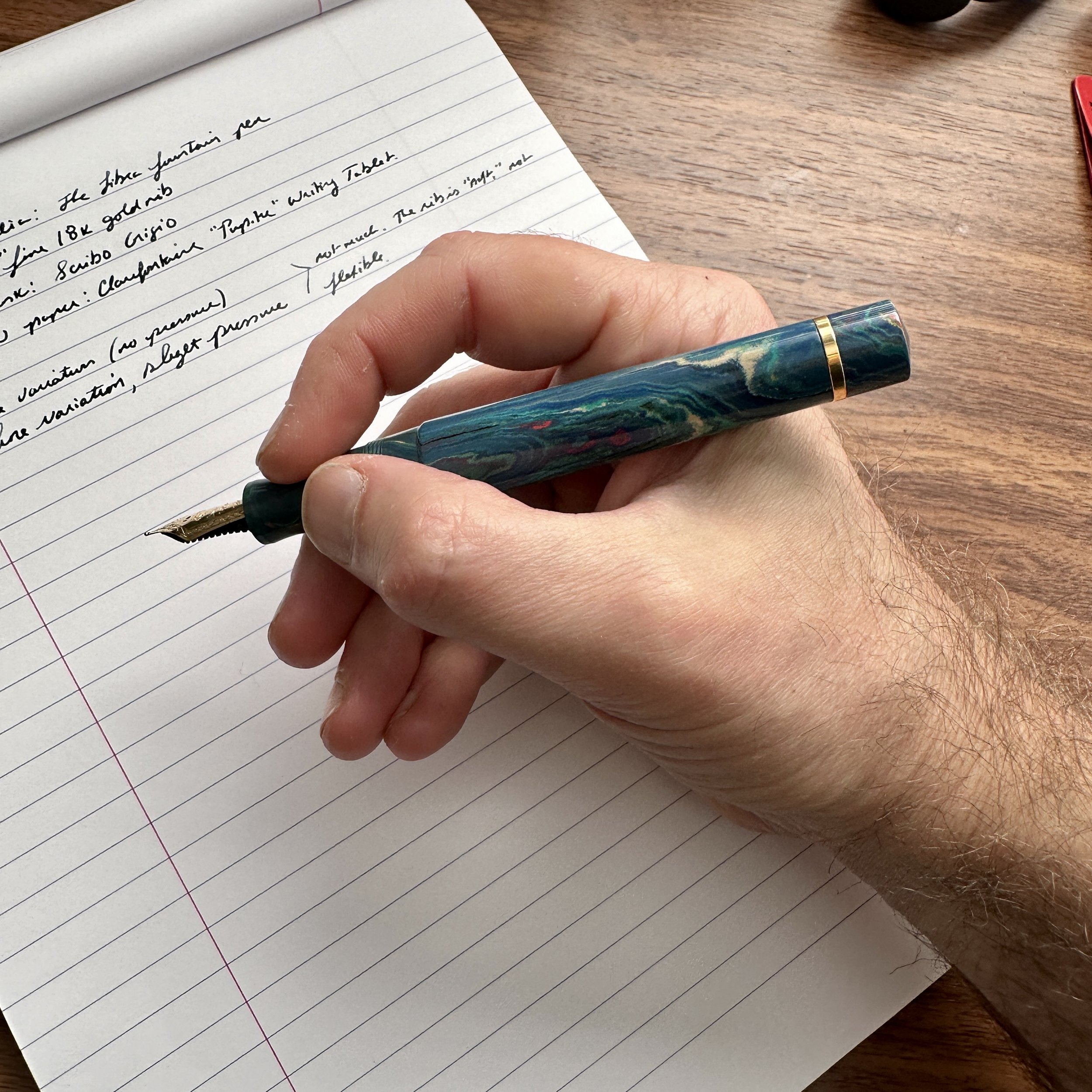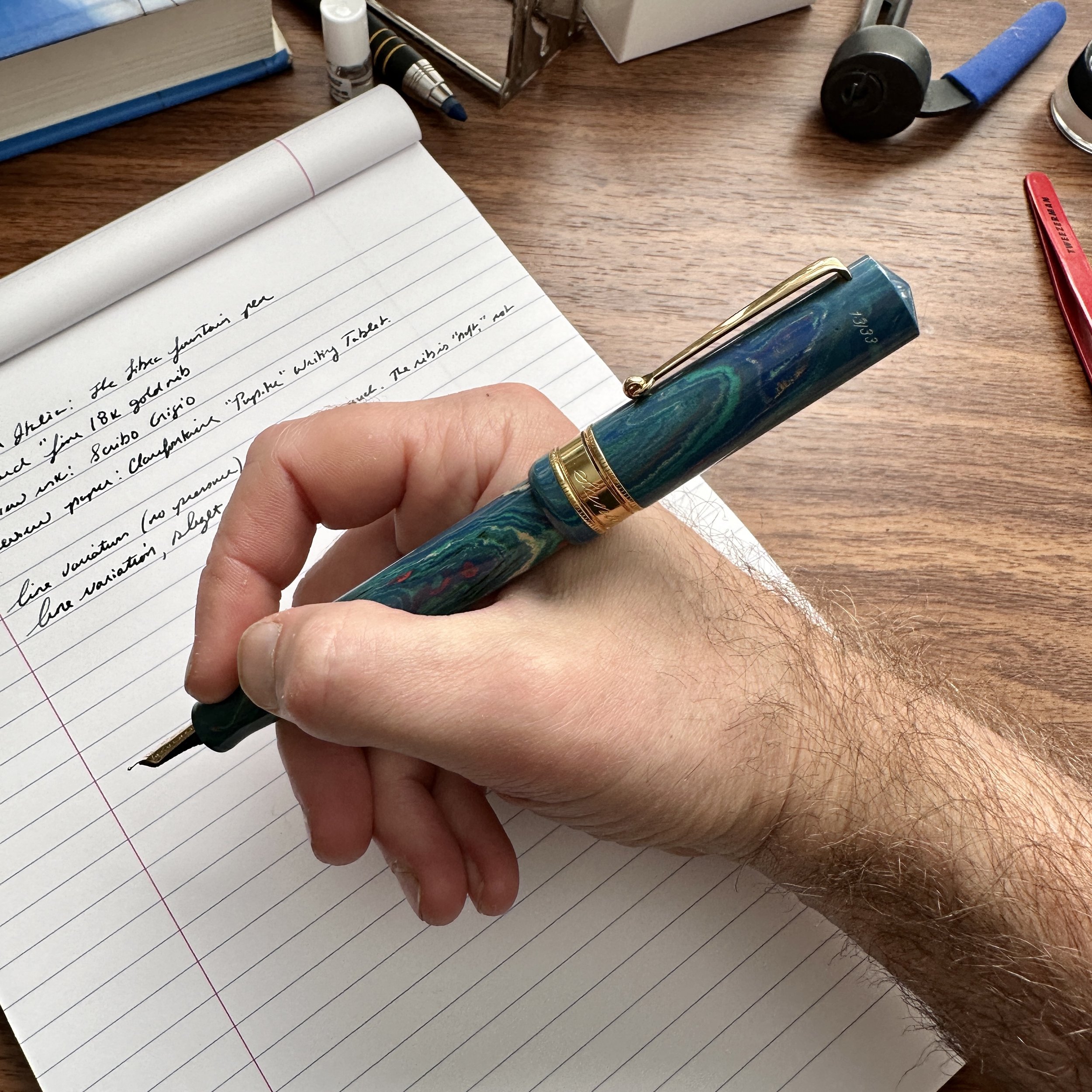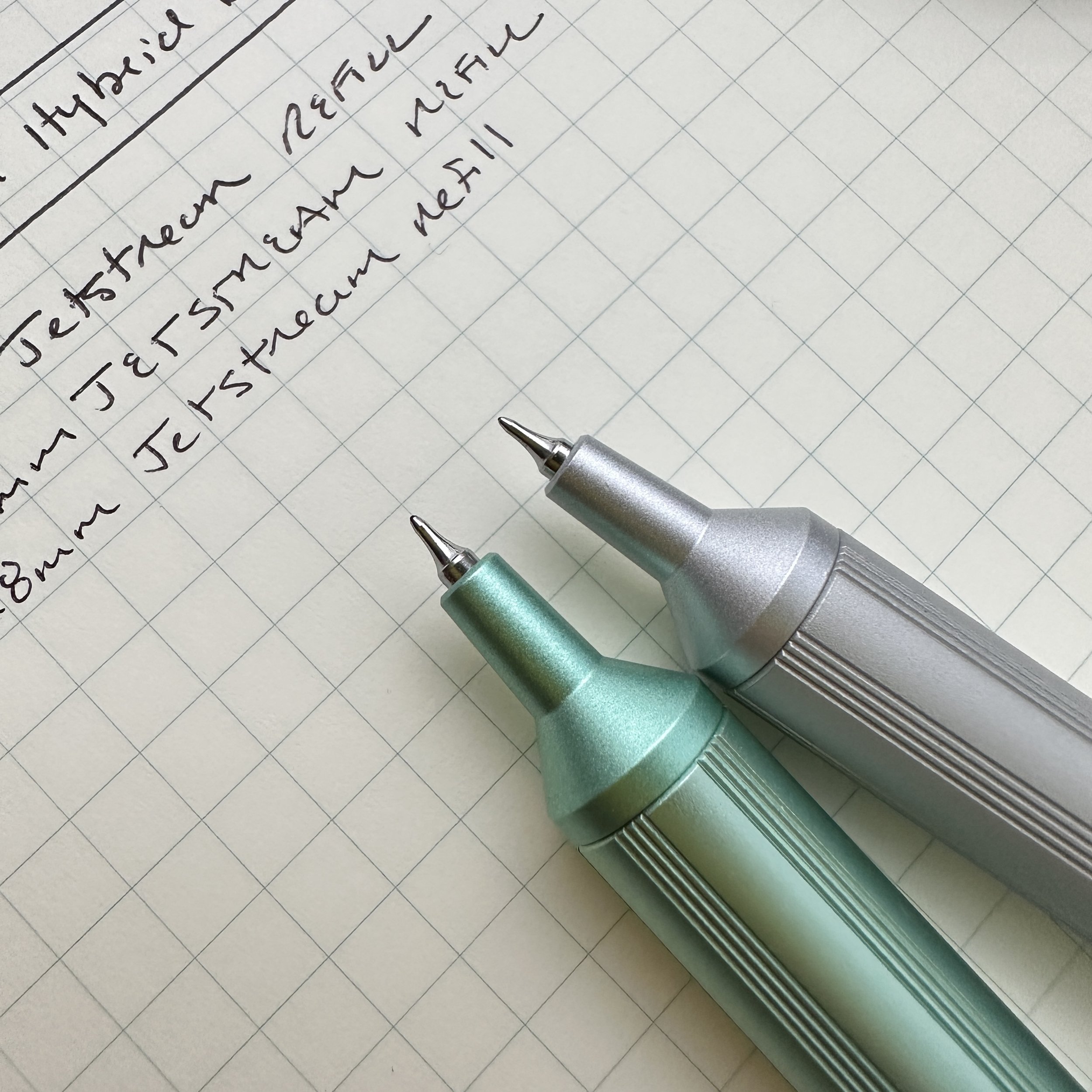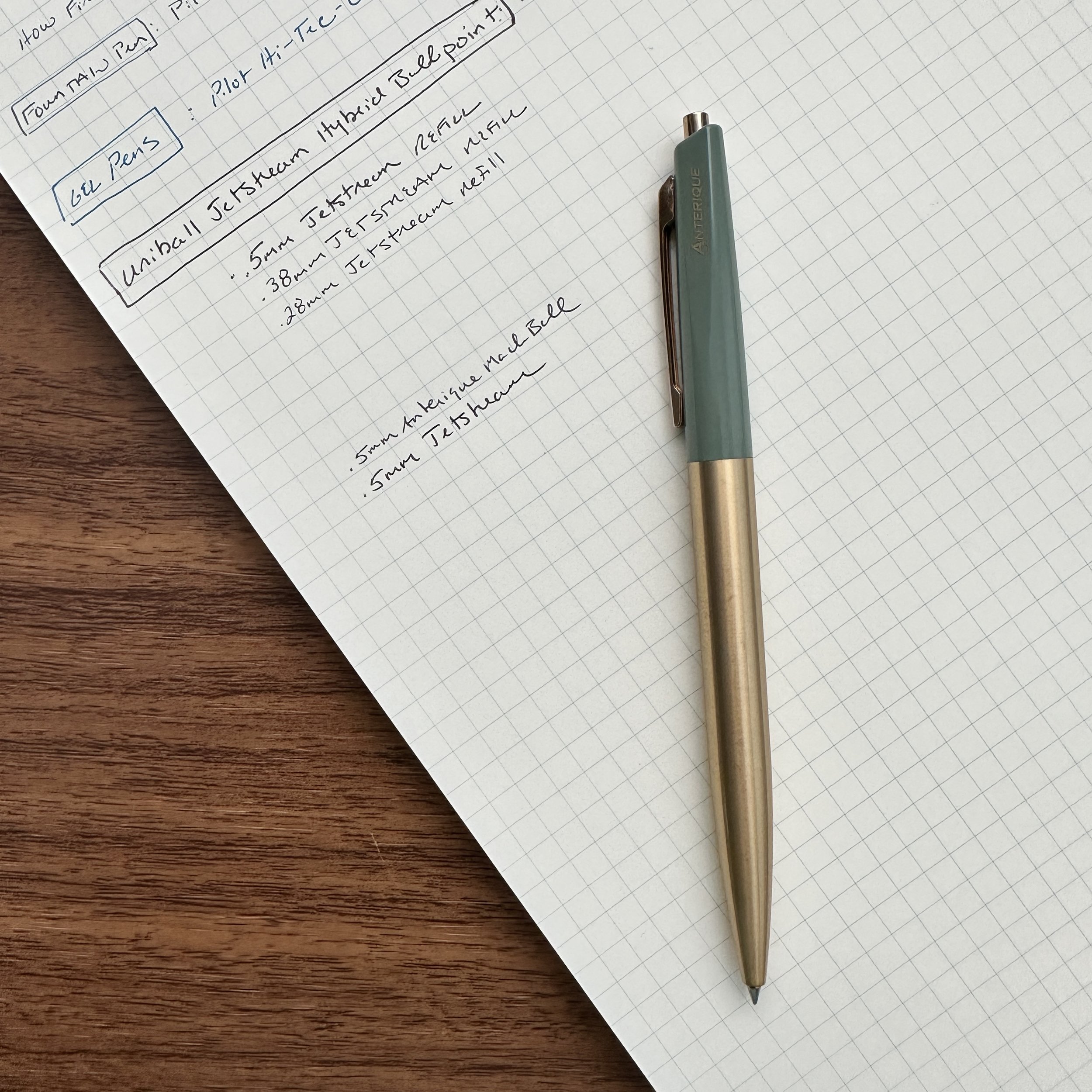Even after all these years, I love that I can still discover new makers, and come away as excited as I was back when I first encountered fountain pens. Santini Italia is not necessarily a new brand - the company and its principals have been manufacturing pens since 1998 - but their current line has just started to gain traction in the United States, culminating in their attendance at the D.C. Pen Show back in August. While I didn't get to spend an extended amount of time at their table, and most of their wares had sold by the time I was able to make it over, a friend from my local pen club was kind enough to lend me her Santini Libra in ebonite for review!
I don’t believe this particular ebonite is still available for purchase, but it features multiple shades of blue and turquoise, along with red, pink, and beige mixed in. The combination is gorgeous.
About Santini Italia
Santini Italia is headquartered in Turin, Italy, the same city as famed Italian penmaker Aurora. As I mentioned above, Founder and manager Giovanni Santini has been involved in pen manufacturing for many years. (You can read more on his and the Company's background on their website, which also links to two excellent Pen World profiles.) What makes Santini unique? Their pens are 100% made in-house, from the pen bodies themselves to the nibs and feeds. In today's marketplace, this is rare. Most smaller makers lack the knowledge and/or resources to make their own nibs profitably and with the necessary level of quality control. Santini's 18k in-house nib is entirely their own, comes paired with an in-house ebonite feed, and is also offered with custom nib grinds. Frankly, I’m impressed.
The Libra sports a wide coin-edge cap band inscribed with “Santini Italia".
About the Libra Fountain Pen
Santini describes the Libra fountain pen as "classic, elegant, and light." I would agree with all of that, from the form of the pen itself to the materials chosen. While the Libra features a piston filling system, it's not a heavy pen, leading me to believe that Santini uses something other than brass for their filling mechanism. (Perhaps ebonite or titanium?). I would characterize the profile as classic and vintage-inspired, with a slightly oversized cap and peaked ends, a wide cap band with coin edges, and a roller clip. "Santini Italia" is engraved on the cap band, and while prominent, doesn't appear out-of-place in the overall design of the pen. The Libra is definitely a larger pen, and while it will technically post, I found the pen way too long to be usable posted.
My Santini Writing Experience - All About the Nib
While the pen world's move toward "standard" nibs manufactured by German companies JoWo and Bock certainly has its upside (lower pricing due to economies of scale, interchangeability, ease of repair and customization, etc.) it has also resulted in what some would consider a “uniform” (some would say “consistently boring”) writing experience. Don't get me wrong - I consider JoWo nibs to be reliably smooth writers, and it's hard to beat a well-tuned Bock fine-nib - but at the same time, I love the unique, one-of-a-kind writing experience that you can only get from a nib made and individually tuned in-house.
Though on the ornate side, Santini nibs are tastefully engraved with the company’s “S” logo and 1998, the year in which they started making pens. I also appreciate that the nib size designation is visible on the nib - something that many pen companies omit these days and which I find inconvenient, especially when trying to easily compare nibs.
It took a bit of time to get used to the Santini nib, with its combination of softness and tactile feel. I reviewed a standard 18k fine nib, paired with Santini's ebonite feed. Overall, I would describe the Santini writing experience as "bouncy", and you of course have the option of a true flex nib if you'd like more line variation. It definitely writes on the wetter side. The closest comparison I can make to another nib would be Scribo, though I found the Santini fine nib more tactile than my extra-fine Scribo, akin to a fine Aurora if the Aurora nib was a bit less stiff. (If you'd like to read previous reviews of both Scribo and Aurora fountain pens, visit the T.G.S. Fountain Pen Review Archive.) Personally, I enjoy my nibs when they’re on the more tactile side: with Santini, those looking for a more "glassy smooth" feeling should probably opt for a nib that lays down more ink, possibly a medium, broad, or even a stub.
A writing sample from the Santini Libra: The paper is a ruled Clairefontaine “Pupitre” writing tablet, and the ink shown here is Scribo Grigio, a dark grey-blue.
Santini Price Points and Where to Buy
As one might expect from a luxury, small-batch maker that designs and manufactures their pens 100% in-house, Santini pens are not inexpensive, though the Libra remains relatively accessible. In fact, the Libra sits at the lower end of Santini's product range. Available in either acrylic (269 Euros) or ebonite (369 Euros), this pen - at least to me - represents incredible value for the combination of materials, craftsmanship, and artistry, especially compared to many other European makers whose price increases only seem to have accelerated in recent years. Santini makes several other models as well, including the Toscana (starting at 269 Euros), the nine-sided faceted Nonagon (starting at 460 Euros), and the Giant (which sports a No. 8 nib and sells for 630 Euros). While not inexpensive, I found none of these prices particularly eye-popping, considering they all include 18k gold nibs and most include an integrated filling system. All pens can be purchased directly from Santini Italia via their online shop, and I was not compensated in any way for this review.
Santini’s ebonite pens are typically released in runs of 33, and numbered on the cap.
Conclusions and Takeaways
While I would ordinarily want to spend more time with a fountain pen before reviewing it, especially a pen from a brand I've never used, this pen doesn't belong to me and it sadly needs to go home. That said, I've seen enough to know that I will eventually want to acquire at least one Santini pen for my personal collection, and I'd love to be able to compare the Libra against one of Santini’s higher-end offerings such as the faceted Nonagon or the Giant with that magnificent looking nib. Here's to hoping that Santini returns to the D.C. Pen Show (or better yet, another show before August), though I suspect I will have another Santini Pen in hand well before then!
The Santini Italia Libra, shown here compared to the Montblanc 146 Ultra Black and the Aurora 88 Sigaro Blu.
Further Information: Check Out Our YouTube Channel!
I’ve decided to supplement this review by filming a short video showcasing a few of the pen’s attributes discussed in this review, namely the ebonite material and the nib. The video also includes a writing sample. You can view the video here on our YouTube Channel!
Did you find this review enjoyable and/or informative? If so, please consider supporting us by visiting the T.G.S. Curated Shop, and/or consider joining the T.G.S. Patreon Program! Patreon members enjoy exclusive content, access to meetups, sample sales and more.




